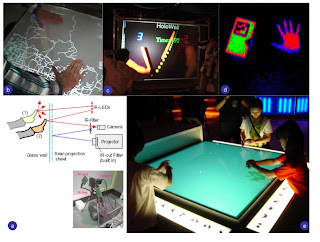Verplank Reading:
The Verplank reading outlined different methods and tactics for the design of interactive products or services.SKETCHING - INTERACTION - DESIGN - PARADIGMS.
1 - Sketch:
Verplank argues that sketching is cruial to an understanding of design as a whole. It allows us to plan and see what is next to come.imagine-see-draw.
Design is an iterative cycle and sketching helps us break out of orbits of thinking'
2 - Interaction:
When designing a product it is essential to consider humans are the centre of the process.Also, Interaction designers strive to answer three questions.
1. How do you do?
2. How do you feel?
3. How do you know?
- essentially, its about understanding these cognitive processes and using them to design better products.
All explained through a "light switch" metaphor.
How do you feel? = HOT AND COLD.
How do you know?
Mapping or Path?
What this breaks down to is, does the person see the task/product/system as one path, or do they see all possible solutions/actions at once?
This also relates to media usage
This also relates to media usage
3 - Design
Interaction design involves the user both comprehending a step-by-step process as well an understanding of the whole product/interaction process.
4 - Paradigms
- Important to develop product that don't exactly think for us, rather become extensions of our own body and mind. Once these products are do so, they become easier to understand.
Types of Paradigms:
- Brain - Tool - Media - Life - Vehicles - Fashion
- Reading emphasises Brain/Tool/Media
- Product as a:
Moving beyond just processing. In the future their will be more of a push to develop computers that can understand human emotions and respond accordingly
Tool:
Best description for the current usage of a product. In essence, products should further strive to be an extension of the self.
Media:
Emphasises the use of a product, in particular, computer interactions as a form of expression.
Media Consumption + Artistic Display.
Designing Kinetic Interactions for Organic User Interfaces:
Amanda Parkes, Ivan Poupyrev and Hiroshi Ishii.
Kinetic Interactions:
- Recently, a push towards to make better, more organic interaction possibilities.
- Actuation = The use of movement to promote action
Parkes/Poupyrev/Ishii Article examines Interaction and Actuation in its several forms
Actuation as:
- Dynamic Physical Controls
- As the embodiment of information
- As the embodiment of gesture
- Actuation as form generation
Organic User Interfaces: Designing Computers in Any Way, Shape or Form
David Holman and Roel Vertegaal
This reading was a really great eye-opener for some cool design ideas.
particularly the "Jelly Mouse"
TUI:
Tangible and Ubiquitous
TUIs present a tighter coupling between "Input/Output"
OUI:
Organic User Interface.
- Use flexible technologies to create interaction in a variety of surfaces (etc.) and contexts.
- e-ink
When Designing OUIs. You Must Consider:
- a 'non-planar display'
- emphasise flexibility.
- promote wellbeing through flexibility and ergonomics
- sustainable usage.
THREE PRINCIPLES OF OUIs:
1. INPUT/OUTPUT:
On a GUI, input and output differ, while on a OUI, the Input and Output are not distinguishable from its graphical output.
2. Function Equals Form:
OUIs should look like what they do.
3. Form Follows Flow:
OUIs should adapt.
early example = Clamshell Phone, GUMMI and several prototype paper interfaces.
particularly the "Jelly Mouse"
TUI:
Tangible and Ubiquitous
TUIs present a tighter coupling between "Input/Output"
OUI:
Organic User Interface.
- Use flexible technologies to create interaction in a variety of surfaces (etc.) and contexts.
- e-ink
When Designing OUIs. You Must Consider:
- a 'non-planar display'
- emphasise flexibility.
- promote wellbeing through flexibility and ergonomics
- sustainable usage.
THREE PRINCIPLES OF OUIs:
1. INPUT/OUTPUT:
On a GUI, input and output differ, while on a OUI, the Input and Output are not distinguishable from its graphical output.
2. Function Equals Form:
OUIs should look like what they do.
3. Form Follows Flow:
OUIs should adapt.
early example = Clamshell Phone, GUMMI and several prototype paper interfaces.
Organic Interaction Technologies: From Stone to
Skin
Jun Rekimoto
Again, another fairly brief introduction into interaction concepts. However, the reading was eye-opening as it clearly stated the limitations of current computer systems, a concept i'd never really thought about before having grown up and used to such input and output systems.
Interaction Concepts:
Holo-Wall:
SmartSkin:
Presense Touch
Interaction Concepts:
Holo-Wall:
SmartSkin:
Presense Touch
All Images from: http://www.organicui.org/?page_id=37
Tangible User Interface and Its Evolution
Hiroshi Ishii
The simplest of the websites articles, Iishi explains that people are developed in a way to interact with their environment (i.e. through our five senses and various brain functions)Essientially, technology does not exploit this.
Inmates Running the Asylum:
Got through the first couple of chapters. Will progress through the book and hopefully have it read by the end of the theory section of the semester




No comments:
Post a Comment